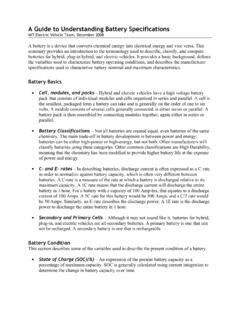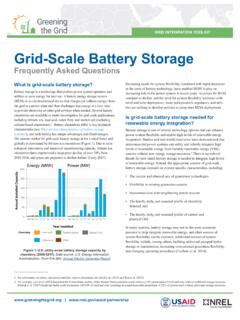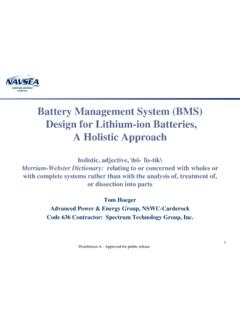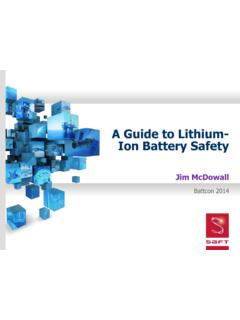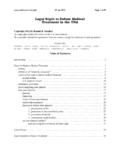Transcription of Guidance Note - fia.uk.com
1 Guidance Note Guidance on Li Ion battery Fires FIA Guidance Document Guidance on Li Ion battery Fires 1. 3. 2. SCOPE .. 3. 3. TERMS AND 3. 4. battery 4. 5. FIRE 4. 6. FIRE 6. 6. 6. 6. GAS 7. FIRE 7. SUPPRESSION AND FIXED 9. GASEOUS FIRE EXTINGUISHING CONDENSED AEROSOL WATERMIST SPRINKLERS WATER DELUGE FOAM 12. WETTING AQUEOUS VERMICULITE POWDER OXYGEN REDUCTION PORTABLE FIRE 7. POST FIRE 15. 15. 8. 16. 9. 16. Guidance Document Guidance on Li Ion battery Fires Version 1 December 2020 Tel: +44 (0)20 3166 5002 2 of 16. 1. INTRODUCTION. This document has been prepared by the FIA Li-ion battery SIG, which comprises FIA.
2 Members and other interested parties and organisations. The SIG is open to FIA members and others with an interest in increasing the understanding of the issue of lithium-ion battery fires and protecting people and property from consequences of these fires. This document represents the current understanding of the industry and will be updated as more information becomes available. 2. SCOPE. This FIA Guidance paper provides information on the issues related to the use of Lithium- ion batteries, how fires start in batteries and on how they may be detected, controlled, suppressed and extinguished.
3 It also provides Guidance on post fire management. Excluded from the scope are explosion and ventilation issues. 3. TERMS AND DEFINITIONS. The block plan should be located at the entrance to the building or close to the fire panel, in a location easily accessible by fire and rescue services or other interested parties. battery a container consisting of one or more cells, in which chemical energy is converted into electricity and used as a source of power. L ithium-ion battery a rechargeable battery that uses lithium-ions as the primary component of its electrolyte. E nergy Storage the capture of energy produced at one time for use at a later time.
4 E nergy Storage System collection of batteries used to store energy. E lectric Vehicle vehicle which uses one or more electric motors for propulsion. attery Management System (BMS). B. electronic system that manages a rechargeable battery . T hermal Runaway exothermic chemical reaction generating more heat than is being dissipated, note: this can be characterised where a self-heating rate of 10oC/min or greater occurs. Thermal Propagation Where a single battery cell thermal runaway spreads to neighbouring cells. F ire Tetrahedron elements required to sustain a fire - Fuel, Heat, Oxygen and a Chemical Chain Reaction.
5 Ff-gassing O. venting of flammable/ toxic electrolyte vapours. Guidance Document Guidance on Li Ion battery Fires Version 1 December 2020 Tel: +44 (0)20 3166 5002 3 of 16. 4. battery TYPES. Lithium-ion batteries vary widely, and continue to evolve, in terms of their materials of construction, chemistry and configuration. Lithium-ion batteries are rechargeable (as opposed to lithium batteries which are not) and all contain lithium-ions in a flammable electrolyte. They do not contain any free lithium metal. Cell enclosures may typically be metal or polymer used to configure as cylinders (jellyroll), pouch/polymers (squashed jelly roll/ books/sheets) or prismatic.
6 Cathodes are an oxide coated lithium, such as lithium cobalt oxide with an anode, such as graphite, in an electrolyte with a poly film separator. The batteries vary in size and configuration depending on their use and application. Larger batteries may be found in Energy Storage Systems (ESS) and vehicles whilst smaller batteries are used in laptops and mobile phones with lots of intermediate applications. Batteries are arranged in series to increase voltage, and in parallel to increase capacity. 5. FIRE ISSUES. As Lithium-ion batteries do not contain any free lithium metal (as stated above) they should not be regarded as a metal' fire threat.
7 Ways fires can start: Internal manufacturing defects (material defects, construction, contamination). Physical damage (during assembly, shipping, handling, waste disposal, accidental during product use). Electrical abuse (overcharging, over - discharging, short circuit). Thermal abuse (exposure to high temperatures). Cell failure results in a voltage drop and increasing heat release and signals the start of thermal runaway'. This typically develops through the following events: 1. Temperature increase 2. Venting/gassing off of flammable/toxic electrolyte vapours 3. Flare 4.
8 Steady burn 5. Flash fireball 6. Explosion Thermal Runaway starts in a single cell before thermal propagation creates a domino effect through the adjacent cells. Defects and physical damage can create internal short circuits leading to cell failure. Other events which could lead to cell failure arise external to the cells and so may be detected. The thermal runaway phase exhibits increasing temperature and heat release plus venting/. gassing off of flammable/ toxic electrolyte. This accelerates as cell failure approaches. Guidance Document Guidance on Li Ion battery Fires Version 1 December 2020 Tel: +44 (0)20 3166 5002 4 of 16.
9 The battery cell surface temperature during external heating (oven) abuse test, showing the temperature rise upon external heating and the rapid temperature peak due to thermal runaway for two types of cobalt based cells (Samsung and Sanyo) and for a lithium iron phosphate cell (K2 Energy). All three cells are of the 18650 type. Reprinted with permission of F. Larsson [3]. Lithium-ion batteries, for example those used to power electric vehicles are in fact many hundreds, even thousands of individual cells, which may look similar in some respects to a packaging of regular AA battery and the issue is that, if they overheat and catch fire or even explode, the reaction quickly passes to the next cell and so on.
10 This can happen due to short circuits, faulty design, physical damage, poor manufacturing processes etc; battery manufacturers introduce safety devices/controls that aim to detect abnormal conditions developing and shutting down the batteries before it gets to thermal runaway. Monitoring of off-gases is also used to detect abnormal conditions developing. Guidance Document Guidance on Li Ion battery Fires Version 1 December 2020 Tel: +44 (0)20 3166 5002 5 of 16. 6. FIRE SOLUTIONS. General This section considers the various fire solutions available which are protection, detection, suppression and extinguishing.

